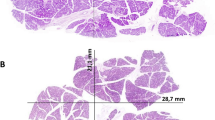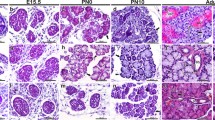Abstract
The present work was aimed to investigate the histochemical and immunohistochemical features of the parotid and submandibular salivary glands in the porcupine. Three adult male animals were included in the current study. Histochemical properties of the glands were studied using Periodic acid-schif (PAS), Alcian blue (AB) (pH = 2.5), and Aldehyde fuchsin (AF). The expression rate of MUC-, Ck7 and S100 was investigated immunohistochemically. The parotid gland was triangular at the base of external ear, and the submandibular was rectangular and larger than parotid. The parotid duct was passed over the dorsal border of masseteric muscle, however, the submandibular duct was positioned on the ventral border of the masseteric muscle. Histochemically, the parotid gland had mucous acini with positive reaction to AB and AF and so week reaction to PAS. This indicated acidic and sulfated mucous secretion for parotid gland. The submandibular gland was composed of mucous acini that showed negative reaction to AB, AF, and PAS stains. The submandibular gland secretion was a non-acidic and non-sulfated saliva. The MUC1 wasn’t expressed nor in parotid and submandibular glands. Ck7 marker was expressed extensively in ductal epithelial cells of both glands. S100 protein showed wide expression in the myoepithelial cells of parotid gland. However, its expression was rare in submandibular gland. In conclusion, the present findings indicated that major salivary glands in the porcupine have species-specific features. This knowledge would be useful in future studies for deeper understanding of the detailed histophysiology of the digestive system in zoo animals.







Similar content being viewed by others
Data availability
There is no data for sharing.
References
Adnyane IKM, Zuki AB, Noordin MM, Agungpriyono S (2010) Histological study of the parotid and mandibular glands of barking deer (Muntiacus muntjak) with special reference to the distribution of carbohydrate content. Anat Histol Embryol 39(6):516–520
Almasi M, Goodarzi N (2022) Microanalysis of the stomach of southern white-breasted hedgehog (Erinaceus concolor): Histological, histochemical, immunohistochemical, and scanning electron microscopic studies. Microsc Res Tech 85:2714–2728
Al-Okaili AG, Sedeeq BI, Hazeem MI (2008) Histological changes of the submandibular salivary gland of mice maintained on a liquid diet. Tikrit J Pure Sci 4(3):22–25
Al-Saffar FJ, Simawy MSH (2014) Histomorphological and histochemical study of the major salivary glands of adult local rabbits. Int J Adv Res 2(11):378–402
Bellavia SL, Sanz EG, Sereno R, Vermouth NT (1992) Alpha-amylase circadian rhythm of young rat parotid: an endogenous rhythm with maternal coordination. Arch Oral Biol 37:429–433
Cowley LH, Shackleford JM (1970a) An ultrastructural study of the Gl Mandibulariss of the squirrel monkey. Saimiri Sciureus. J Morphol. 132(2):117–135
Cowley LH, Shackleford JM (1970b) Electron microscopy of squirrel monkey Gl. Parotiss Alabama J Med Sci 7:273–282
Demirsoy A (1992) Rodentia. The base rules of life. Meteksan Anonim Sirketi Ankara. 11:695–729
Dyce KM, Sack WO, Wensing CJG (2009) Textbook of veterinary anatomy-E-Book. Elsevier Health Sci
Estecondo S, Codón SM, Casanave EB (2005) Histological study of the salivary glands in Zaedyus pichiy (Mammalia, Xenarthra, Dasypodidae). Int J Morphol 23(1):19–24
Hall JE, Hall ME (2016) Guyton and Hall textbook of medical physiology. Jordanian edition E-book, 14th edn, Elsevier Health Sciences
Hamphery RDH, Williamson RT (2021) A review of saliva: normal composition, flow, and function. J Prosthet Dent 85(1):162–169
Ikpegbu E, Nlebedum UC, Nnadozie O, Agbakwuru IO (2013) The submandibular salivary gland microscopic morphology of the adult African giant pouched rat Cricetomys gambianus, waterhouse-1840. Iraqi J Vet Sci. 27:85
Kanaji N, Bandoh S, Fujita J, Ishii T, Ishida T, Kubo A (2007) Compensation of type I and type II cytokeratin pools in lung cancer. Lung Cancer 55:295–302
Khojasteh SMB, Delashoub M (2012) Microscopic anatomy of the parotid and submandibular salivary glands in European hamster (Cricetus cricetus L). Int Res J Appl Basic Sci. 3(7):1544–1548
Kimura J, Habata I, Endo H, Rerkamnuagchoke W, Kurohmaru M, Yamada J, Nishida T, Tsukise A (1998) Histochemistry of comoplex carbohydrate in the major salivary glands of Hoary Bamboo rats (Rhizomys purinosus). Anat Histol Embryol 27:147–153
Kumar B, Kashyap N, Avinash A, Chevvuri R, Sagar MK, Kumar S (2017) The composition, function and role of saliva in maintaining oral health: a review. Int J Contemp Dent Med Rev. https://doi.org/10.15713/ins.ijcdmr.121:1-6
Lin F, Prichard J (2011) Handbook of practical immunohistochemistry: frequently asked questions. Freq Asked Quest. https://doi.org/10.1007/978-1-4419-8062-5_12
Marenholz I, Heizmann CW, Fritz G (2004) S100 proteins in mouse and man: from evolution to function and pathology (including an update of the nomenclature). Biochem Biophys Res Commun 322(4):1111–1122
Massoud D, Bin-Meferig MM, El-kott AF, Abd El-Makhsoud MM, Negm S (2022) Histology and histochemistry of the major salivary glands in the southern white-breasted hedgehog (Erinaceus concolor). Anat Histol Embryol 52:254–261
Memari B, Bouttier M, Dimitrov V, Ouellette M, Behr MA, Fritz JH, White JH (2015) Engagement of the aryl hydrocarbon receptor in mycobacterium tuberculosis-infected macrophages has pleiotropic effects on innate immune signaling. J Immunol 195(9):4479–4491
Parks HF (1961) On the fine structure of the Gl Parotis of mouse and rat. Am J Anat 108(3):303–329
Poddar S, Jacob S (1977) Gross and microscopic anatomy of the major salivary glands of the ferret. Cells Tissues Organs 98(4):434–443
Redman RS (1994) Myoepithelium of salivary glands. Micros Res Tech 27(1):25–45
Schneyer LH, Schneyer CA (1967) Inorganic composition of saliva. Am Physiol Soc. 2:9845
Sisson S, Grossman JD, Getty R (1975) Sisson and Grossman’s the anatomy of the domestic animals, vol 2, 5th edn. W.B. Saunders Co., Philadelphia
Striefler JK, Riess H, Lohneis P, Bischoff S, Kurreck A, Modest DP et al (2021) Mucin-1 Protein Is a prognostic marker for pancreatic ductal adenocarcinoma: results From the CONKO-001 study. Front Oncol 11:670396
Tandler B, Erlandson RA (1976) Ultrastructure of baboon Gl. Parotis Anat Rec 184(1):115–131
Triantafyllou A, Fletcher D, Scott J (2005) Organic secretory products, adaptive responses and innervation in the Gl. parotis of ferret: a histochemical study. Archiv Oral Biol 50:769–777
van Lennep EW, Kennerson AR, Compton JS (1977) The ultrastructure of the sheep Gl. Parotis Cell Tissue Res 179(3):377–392
Xin Z, Jun L, Xiao-yong L, Yi-lin S, Chun-mei Z, Song-ling W (2005) Morphological characteristics of Gl Mandibulariss of miniature pig. Chin Med J 118(16):1368–1373
Acknowledgements
The authors would like to appreciate the financial support of the Deputy of Research and Technology, Razi University
Author information
Authors and Affiliations
Contributions
N.G. wrote the main manuscript and interpreted histological and immunohistochemical sections. A.K. contributed in the samples preparation and tissue section handling. All authors reviewed the manuscript.
Corresponding author
Ethics declarations
Conflict of interest
The authors declare that they do not have any conflict of interest.
Additional information
Publisher's Note
Springer Nature remains neutral with regard to jurisdictional claims in published maps and institutional affiliations.
Rights and permissions
Springer Nature or its licensor (e.g. a society or other partner) holds exclusive rights to this article under a publishing agreement with the author(s) or other rightsholder(s); author self-archiving of the accepted manuscript version of this article is solely governed by the terms of such publishing agreement and applicable law.
About this article
Cite this article
Goodarzi, N., Kahrizi, A. Histochemistry and immunohistochemistry of the parotid and submandibular salivary glands in Hystrix indica. Zoomorphology 142, 509–517 (2023). https://doi.org/10.1007/s00435-023-00614-7
Received:
Revised:
Accepted:
Published:
Issue Date:
DOI: https://doi.org/10.1007/s00435-023-00614-7




